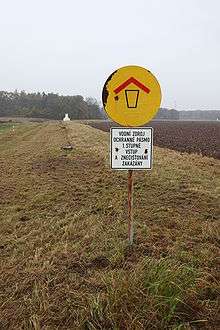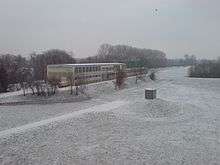Bank filtration
River Bank filtration is a type of filtration that works by passing water to be purified for use as drinking water through the Banks of a river or lake. It is then drawn off by extraction wells some distance away from the water body. The process may directly yield drinkable water, or be a relatively uncomplicated way of pre-treating water for further purification.[1]
Procedure

Three filtration mechanisms are possible. Physical filtration or straining takes places when suspended particulates are too large to pass through interstitial spaces between alluvial soil particles. Biological filtration occurs when soil microorganisms remove and digest dissolved or suspended organic material and chemical nutrients. Chemical filtration or ion exchange may take place when aquifer soils react with soluble chemicals in the water.[2] Most 'normal' contaminants (microbial organisms and inorganic or organic pollutants) will be removed by bank filtration, either because they get filtered out by the sand/earth of the bank, or because the passage time (which may be days or potentially weeks) is sufficient to render them inactive.[3] Research has also shown that the removal efficiency depends not only on the contaminant, but also on the "hydraulic and chemical characteristics of the bottom sediment and the aquifer, the local recharge-discharge conditions, and biochemical processes".[1]
There have been indications that some pharmaceutical compounds (medical drug traces from human use) may not always be sufficiently removed by bank filtration, and that in areas with substantial contamination of this type, additional treatment may be needed.[1]
History
The process has been in use in Europe, especially in Germany along the Rhine and later in Berlin, since the 1870s. Major facilities also exist in many other countries, including the United States, where Nebraska is leading in the use of such facilities.[1][3]
Wastewater applications
Alluvial soils may also be used to purify waste-water being returned to a river after use. Treated wastewater is typically discharged into a percolation pond on the alluvial flood plain rather than flowing directly into the river.[4] Chemical filtration will cease when all reactive sites within the flow pathway through aquifer soil have reacted. Physical filtration tends to become more effective as trapped particulates block interstitial passages between alluvial soil particles; but may ultimately limit flow rates through the soil.[5] Particulates on the river side of the soil interface may be periodically scoured away by turbulent flow. Wastewater percolation ponds may require maintenance to break up or remove a scum layer (Schmutzdecke) forming at the bottom of the pond. Biological filtration remains effective unless organic loading causes anaerobic conditions within the riverbed alluvium.[6]
See also
References
- Occurrence and fate of pharmaceuticals during bank filtration Archived 2008-08-29 at the Wayback Machine - Heberer, Thomas et al.; Technical University of Berlin / United States Geological Survey, ca 2001
- Metcalf & Eddy (1972). Wastewater Engineering. McGraw-Hill. p. 644.
- Bank Filtration for Water Treatment (from a Water Resources Research Center, University of Hawaii, Manoa, bulletin, 2000/08. Accessed 2008-03-24.)
- Polar, Jose A. (June 2007). "The Fate of Pharmaceuticals After Wastewater Treatment". Florida Water Resources Journal. Cite journal requires
|journal=(help) - Weber Walter J., Junior (1972). Physicochemical Processes for Water Quality Control. Wiley-Interscience. ISBN 0-471-92435-0.
- Fair, Gordon Maskew; Geyer, John Charles & Okun, Daniel Alexander (1968). Water and Wastewater Engineering, Volume 2. John Wiley & Sons. pp. 34–4&5.
External links
- BankFiltration.Org (German website promoting advantages of and research into bank filtration)
